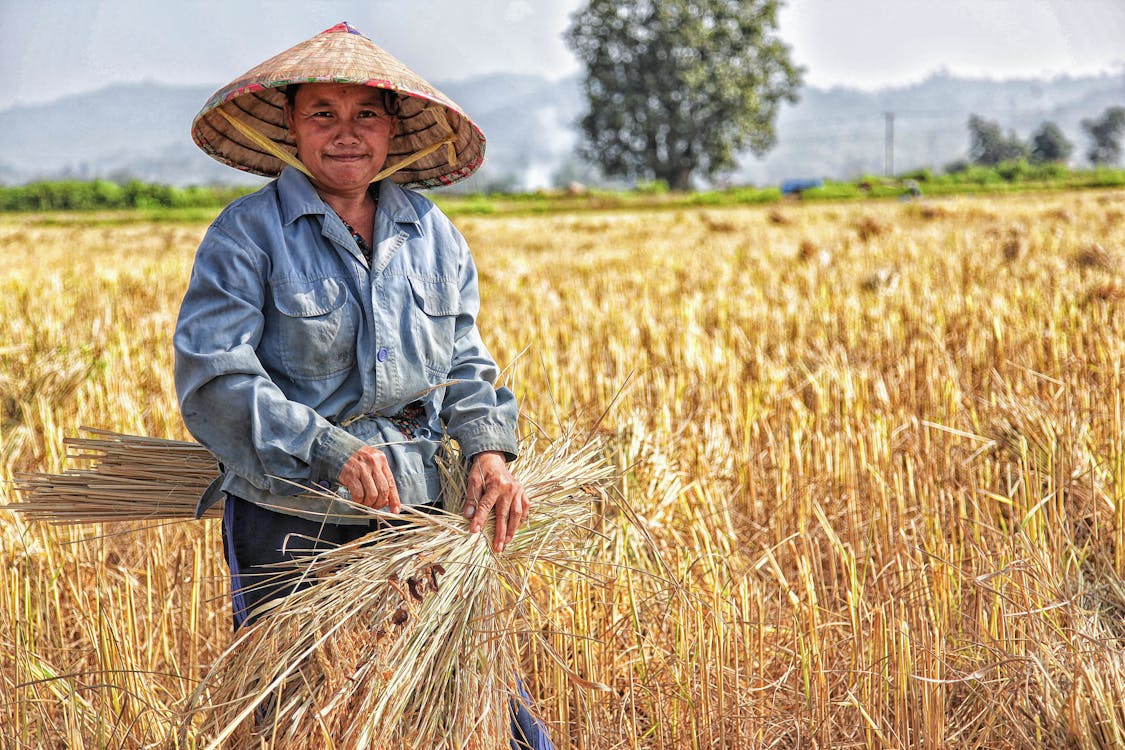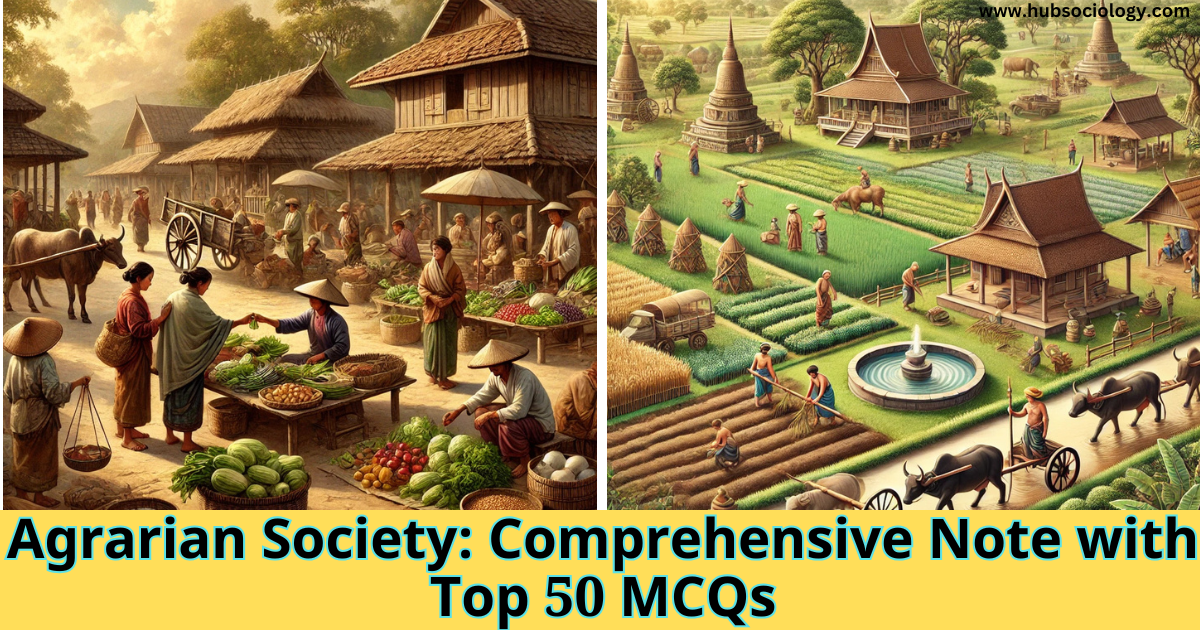Agrarian societies have played a crucial role in the historical development of human civilization. Defined by their dependence on agriculture as the primary means of sustenance and economic activity, these societies exhibit unique social structures, class divisions, and cultural dynamics. In the words of Karl Marx, “The hand-mill gives you society with the feudal lord; the steam-mill, society with the industrial capitalist” (Marx, The Poverty of Philosophy, 1847). This statement highlights how agrarian societies, shaped by their modes of production, differ significantly from industrial and post-industrial societies.

Sociologists have long studied agrarian societies to understand their economic foundations, power structures, and impact on human development. This article delves into the sociological aspects of agrarian society, exploring its historical significance, class hierarchies, gender roles, and the transition towards industrialization.
Definition and Characteristics of Agrarian Society
An agrarian society is primarily based on large-scale agriculture, which forms the foundation of its economy, social hierarchy, and cultural identity. Unlike hunter-gatherer or pastoral societies, agrarian societies rely on domesticated crops, plowing, and permanent settlements.
Sociologist Emile Durkheim emphasized the role of labor division in social organization, stating that “The division of labor is the necessary condition for the intellectual and material development of societies” (The Division of Labor in Society, 1893). In agrarian societies, the division of labor is primarily centered around agricultural production, land ownership, and social stratification.
Key characteristics of agrarian societies include:
- Agricultural Dominance: The primary occupation revolves around farming and livestock.
- Land-Based Economy: Wealth and power are determined by land ownership.
- Rigid Social Hierarchy: The society is divided into landowners, tenants, and laborers.
- Extended Family Structures: Joint families and patriarchal systems dominate social life.
- Religious and Cultural Influence: Agricultural practices are often intertwined with religious beliefs.
Class Structure and Power Dynamics in Agrarian Society
Agrarian societies are often marked by deep class divisions, where landowners control the means of production and peasants work under their authority. Karl Marx’s theory of historical materialism explains that the economic base of a society determines its superstructure, including laws, politics, and ideology.
Marx and Friedrich Engels, in The Communist Manifesto (1848), argue that “The history of all hitherto existing society is the history of class struggles.” In agrarian societies, this struggle is often between:
- Feudal Lords and Peasants: In medieval Europe, the feudal system exemplified this division, where landlords controlled vast estates, and serfs worked under their command.
- Landlords and Tenant Farmers: In colonial India, the Zamindari system reflected a similar power structure, where zamindars collected rent from peasants, reinforcing economic disparity.
- Caste-Based Hierarchies: In societies like India, caste played a significant role in determining agricultural labor roles and access to land ownership.
Max Weber, in his work Economy and Society (1922), introduced the concept of status groups, explaining that in agrarian societies, social stratification is not merely based on economic class but also on status and power derived from tradition and religion.
Gender Roles in Agrarian Society
Agrarian societies exhibit distinct gender roles, largely shaped by agricultural labor and patriarchal traditions. Women primarily engage in domestic work, child-rearing, and assisting in farm-related activities. However, their economic contributions often remain unrecognized.
Sociologist Sylvia Walby, in Theorizing Patriarchy (1990), argues that “Agriculture intensified patriarchal relations by reinforcing men’s control over land, labor, and inheritance.” This structural dominance of men in agrarian societies led to the subordination of women in both economic and social spheres.
Religion and Culture in Agrarian Societies
Religion plays a crucial role in agrarian societies, influencing agricultural practices, festivals, and social customs. The worship of deities associated with fertility and harvest is common. In India, for example, festivals like Pongal and Makar Sankranti celebrate agricultural abundance.
Durkheim, in The Elementary Forms of Religious Life (1912), explains that religion functions as a social glue, binding individuals through shared beliefs and rituals. In agrarian societies, religious institutions often reinforce existing social hierarchies, legitimizing the power of landowning elites.
The Transition from Agrarian Society to Industrial Society

The decline of agrarian societies began with industrialization, which transformed economic structures and social relations. The Industrial Revolution in the 18th and 19th centuries led to mass migration from rural to urban areas, diminishing the agrarian workforce.
Ferdinand Tönnies, in Gemeinschaft und Gesellschaft (1887), contrasted traditional agrarian societies (Gemeinschaft) with industrial societies (Gesellschaft), highlighting how personal, community-based relationships in agrarian societies were replaced by impersonal, contractual relationships in industrialized settings.
Sociologists have noted that this transition brought both progress and social challenges. While industrialization improved productivity and economic growth, it also led to urban poverty, labor exploitation, and environmental degradation.
Modern Relevance of Agrarian Society
Despite industrialization, agrarian societies still exist, particularly in developing countries where agriculture remains a primary source of livelihood. However, globalization, mechanization, and climate change continue to reshape traditional agrarian economies.
Sociologists such as Amartya Sen have emphasized the need for agrarian reform to address inequalities in land distribution and rural poverty. In his book Development as Freedom (1999), Sen argues that expanding rural education, healthcare, and economic opportunities is crucial for sustainable development.

Conclusion
Agrarian societies have shaped human history through their economic foundations, class structures, and cultural traditions. While industrialization has transformed societies, understanding agrarian life remains vital for addressing contemporary social issues like rural poverty, food security, and environmental sustainability.
As sociologists continue to study agrarian societies, their insights help us appreciate the complexities of human civilization and the ongoing struggles for social justice in rural communities. Whether in historical analysis or modern development discourse, the agrarian society remains a key focus in sociological inquiry.
Related Questions of Agrarian Society
5-Mark Questions (Short Answer Type)
- Define agrarian society with an example.
- Mention any three characteristics of agrarian society.
- How does land ownership influence social hierarchy in agrarian society?
- What is Karl Marx’s perspective on class struggle in agrarian society?
- How did industrialization impact agrarian society?
10-Mark Questions (Brief Descriptive Type)
- Discuss the main features of agrarian society with sociological examples.
- Explain the role of religion in agrarian society as per Emile Durkheim.
- Compare the class structure of agrarian society with industrial society.
- What are the gender roles in agrarian society? Discuss with examples.
- Analyze the transition from agrarian society to industrial society with reference to Tönnies’ Gemeinschaft und Gesellschaft.
15-Mark Questions (Long Descriptive/Essay Type)
- Critically examine the social hierarchy in agrarian society, citing Karl Marx and Max Weber.
- How do agrarian societies contribute to economic and cultural development? Discuss in a sociological context.
- Explain the impact of globalization and modernization on traditional agrarian societies.
- Discuss how agrarian reforms can help reduce inequality in developing countries.
- Compare the perspectives of Karl Marx, Max Weber, and Emile Durkheim on agrarian societies.
MCQs
Section 1: Definition and Characteristics of Agrarian Society
- What is the primary economic activity in an agrarian society?
a) Industrial production
b) Hunting and gathering
c) Agriculture
d) Trade and commerce
Answer: c) Agriculture - Which revolution marked the transition to agrarian society?
a) Industrial Revolution
b) Neolithic Revolution
c) Digital Revolution
d) Green Revolution
Answer: b) Neolithic Revolution - What is a key feature of agrarian society according to Gerhard Lenski?
a) Nomadic lifestyle
b) Use of plow agriculture
c) High technological advancement
d) Egalitarian social structure
Answer: b) Use of plow agriculture - Which of the following is NOT a characteristic of agrarian society?
a) Permanent settlements
b) Surplus food production
c) High social mobility
d) Rigid social hierarchy
Answer: c) High social mobility - Agrarian societies are most closely associated with which type of social stratification?
a) Classless society
b) Feudal system
c) Meritocracy
d) Caste system
Answer: b) Feudal system
Section 2: Social Structure and Stratification
- Who controls the means of production in a feudal agrarian society?
a) Peasants
b) Landowning aristocracy
c) Merchants
d) Artisans
Answer: b) Landowning aristocracy - According to Karl Marx, what is the primary relationship in agrarian society ?
a) Capitalist-worker
b) Feudal lord-serf
c) Employer-employee
d) Hunter-gatherer
Answer: b) Feudal lord-serf - What did Max Weber emphasize as a key factor in agrarian social stratification?
a) Industrialization
b) Landownership
c) Education
d) Technological innovation
Answer: b) Landownership - Which term describes the limited social mobility in agrarian society ?
a) Meritocracy
b) Egalitarianism
c) Social rigidity
d) Capitalism
Answer: c) Social rigidity - In agrarian societies, what role does religion often play?
a) Promotes social equality
b) Legitimizes the existing social order
c) Encourages technological innovation
d) Supports industrialization
Answer: b) Legitimizes the existing social order
Section 3: Cultural and Religious Dimensions
- What is the focus of religious rituals in agrarian societies, according to Emile Durkheim?
a) Industrial progress
b) Agricultural cycles
c) Urban development
d) Technological advancement
Answer: b) Agricultural cycles - Which sociologist studied the symbolic significance of rice cultivation in Javanese culture?
a) Karl Marx
b) Max Weber
c) Clifford Geertz
d) Gerhard Lenski
Answer: c) Clifford Geertz - What is collective consciousness in agrarian societies?
a) A shared set of beliefs and values
b) A focus on individualism
c) A drive for technological innovation
d) A rejection of traditional norms
Answer: a) A shared set of beliefs and values - Which of the following is a common cultural practice in agrarian societies?
a) Celebrating industrial achievements
b) Hosting harvest festivals
c) Promoting urban lifestyles
d) Encouraging social mobility
Answer: b) Hosting harvest festivals - How does religion in agrarian societies reinforce social stability?
a) By promoting individualism
b) By justifying the social hierarchy
c) By encouraging technological change
d) By rejecting traditional norms
Answer: b) By justifying the social hierarchy
Section 4: Economic Systems and Technological Development
- What is the primary economic system in agrarian societies?
a) Capitalism
b) Feudalism
c) Socialism
d) Industrialism
Answer: b) Feudalism - According to Karl Polanyi, what is an embedded economy?
a) An economy driven by market forces
b) An economy integrated into social and cultural institutions
c) An economy focused on industrial production
d) An economy based on wage labor
Answer: b) An economy integrated into social and cultural institutions - Which technological innovation is most associated with agrarian societies?
a) Steam engine
b) Plow
c) Computer
d) Assembly line
Answer: b) Plow - What is the main focus of technological development in agrarian societies?
a) Industrial machinery
b) Agricultural productivity
c) Digital communication
d) Urban infrastructure
Answer: b) Agricultural productivity - Why is landownership significant in agrarian societies?
a) It determines social status and power
b) It promotes industrialization
c) It encourages urbanization
d) It supports wage labor
Answer: a) It determines social status and power
Section 5: Transition to Industrial Society
- What marked the transition from agrarian to industrial society?
a) The Neolithic Revolution
b) The Industrial Revolution
c) The Digital Revolution
d) The Green Revolution
Answer: b) The Industrial Revolution - According to Ferdinand Tönnies, what type of social relationships characterize agrarian societies?
a) Gesellschaft (impersonal)
b) Gemeinschaft (communal)
c) Bureaucratic
d) Contractual
Answer: b) Gemeinschaft (communal) - What is a key difference between agrarian and industrial societies?
a) Agrarian societies rely on manual labor, while industrial societies rely on machinery
b) Agrarian societies are urban, while industrial societies are rural
c) Agrarian societies have high social mobility, while industrial societies do not
d) Agrarian societies reject traditional norms, while industrial societies embrace them
Answer: a) Agrarian societies rely on manual labor, while industrial societies rely on machinery - Which sociologist viewed the transition to industrial society as a process of societal differentiation?
a) Karl Marx
b) Max Weber
c) Herbert Spencer
d) Emile Durkheim
Answer: c) Herbert Spencer - What is a major consequence of the transition from agrarian to industrial society?
a) Decline in population
b) Increase in social rigidity
c) Growth of urban centers
d) Reduction in technological innovation
Answer: c) Growth of urban centers
Section 6: Miscellaneous
- Which of the following is a surplus product in agrarian societies?
a) Excess food
b) Industrial goods
c) Digital services
d) Urban infrastructure
Answer: a) Excess food - What is the primary role of peasants in agrarian societies?
a) Landownership
b) Agricultural labor
c) Industrial production
d) Trade and commerce
Answer: b) Agricultural labor - Which of the following is a limitation of agrarian societies?
a) High technological advancement
b) Slow technological progress
c) Egalitarian social structure
d) High social mobility
Answer: b) Slow technological progress - What is the main source of identity in agrarian societies?
a) Occupation
b) Land
c) Education
d) Technology
Answer: b) Land - Which of the following is a legacy of agrarian societies?
a) Industrial cities
b) Traditional farming practices
c) Digital economies
d) Urban lifestyles
Answer: b) Traditional farming practices
Section 7: Quotes and Theories
- Who said, “In agrarian societies, the gap between the rich and the poor is typically vast”?
a) Karl Marx
b) Max Weber
c) Gerhard Lenski
d) Emile Durkheim
Answer: c) Gerhard Lenski - Which sociologist analyzed agrarian societies in terms of feudal relations of production?
a) Karl Marx
b) Max Weber
c) Emile Durkheim
d) Herbert Spencer
Answer: a) Karl Marx - What did Max Weber emphasize in his analysis of agrarian societies?
a) Class struggle
b) Landownership and patrimonial systems
c) Collective consciousness
d) Social differentiation
Answer: b) Landownership and patrimonial systems - Which sociologist studied the role of religion in maintaining social cohesion in agrarian societies?
a) Karl Marx
b) Max Weber
c) Emile Durkheim
d) Herbert Spencer
Answer: c) Emile Durkheim - Who introduced the concept of the “embedded economy” in agrarian societies?
a) Karl Polanyi
b) Max Weber
c) Gerhard Lenski
d) Ferdinand Tönnies
Answer: a) Karl Polanyi
Section 8: Application and Analysis
- Which of the following is an example of an agrarian society?
a) Medieval Europe
b) Modern Japan
c) Industrial Britain
d) Contemporary United States
Answer: a) Medieval Europe - What is a major challenge faced by agrarian societies today?
a) Overindustrialization
b) Urbanization
c) Climate change
d) Digital divide
Answer: c) Climate change - How does surplus production in agrarian societies contribute to social complexity?
a) By reducing the need for labor
b) By enabling the development of specialized roles
c) By promoting egalitarianism
d) By encouraging urbanization
Answer: b) By enabling the development of specialized roles - Which of the following is a cultural symbol in agrarian societies?
a) Factories
b) Plows
c) Computers
d) Skyscrapers
Answer: b) Plows - What is the primary reason for the persistence of traditional norms in agrarian societies?
a) High social mobility
b) Strong collective consciousness
c) Rapid technological change
d) Urbanization
Answer: b) Strong collective consciousness
Section 9: Comparative Analysis
- How do agrarian societies differ from industrial societies in terms of labor?
a) Agrarian societies rely on wage labor, while industrial societies rely on manual labor
b) Agrarian societies rely on manual labor, while industrial societies rely on machinery
c) Both rely on manual labor
d) Both rely on machinery
Answer: b) Agrarian societies rely on manual labor, while industrial societies rely on machinery - Which of the following is a characteristic of industrial societies but not agrarian societies?
a) Rigid social hierarchy
b) High social mobility
c) Dependence on agriculture
d) Collective consciousness
Answer: b) High social mobility - What is a key difference between agrarian and post-industrial societies?
a) Agrarian societies focus on agriculture, while post-industrial societies focus on services
b) Agrarian societies are urban, while post-industrial societies are rural
c) Agrarian societies have high social mobility, while post-industrial societies do not
d) Agrarian societies reject traditional norms, while post-industrial societies embrace them
Answer: a) Agrarian societies focus on agriculture, while post-industrial societies focus on services - Which of the following is a common feature of both agrarian and industrial societies?
a) Dependence on agriculture
b) Social stratification
c) Nomadic lifestyle
d) Egalitarianism
Answer: b) Social stratification - How does the role of religion differ in agrarian and industrial societies?
a) Religion is more central in agrarian societies
b) Religion is more central in industrial societies
c) Religion plays no role in agrarian societies
d) Religion plays no role in industrial societies
Answer: a) Religion is more central in agrarian societies
Section 10: Critical Thinking
- Why is the study of agrarian societies relevant today?
a) To understand the origins of social inequality
b) To promote industrialization
c) To reject traditional norms
d) To encourage urbanization
Answer: a) To understand the origins of social inequality - What is a potential drawback of the rigid social hierarchy in agrarian societies?
a) Increased social mobility
b) Resistance to change
c) Promotion of egalitarianism
d) Rapid technological progress
Answer: b) Resistance to change - How does the concept of collective consciousness apply to modern societies?
a) It explains the rise of individualism
b) It highlights the importance of shared values
c) It promotes technological innovation
d) It encourages urbanization
Answer: b) It highlights the importance of shared values - What is a key lesson from agrarian societies for sustainable development?
a) The importance of industrial growth
b) The need to balance agriculture and environmental conservation
c) The rejection of traditional practices
d) The focus on urbanization
Answer: b) The need to balance agriculture and environmental conservation - Which of the following best describes the legacy of agrarian societies?
a) A focus on industrial production
b) A deep connection to land and tradition
c) A rejection of social hierarchy
d) A drive for technological innovation
Answer: b) A deep connection to land and tradition

6 thoughts on “Agrarian Society: Comprehensive Note with Top 50 MCQs”